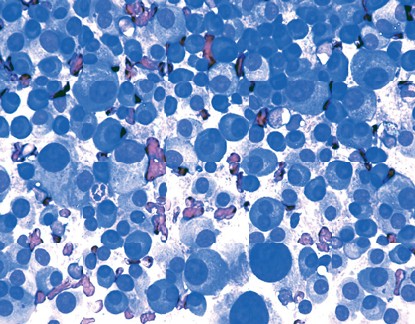MKSAP Quiz: Progressive, worsening fatigue
A 59-year-old man is evaluated for a 4-day history of progressive worsening of fatigue, forgetfulness, constipation, excessive thirst and increased urination. He has no pain. The patient has hypertension, treated with hydrochlorothiazide, and type 2 diabetes mellitus, controlled by diet. He developed right lower lobe streptococcal pneumonia 3 months ago.
On physical examination, he appears somnolent but is easily arousable. Temperature is 37.1°C (98.8°F), blood pressure is 110/70 mm Hg, pulse rate is 120/min, and respiration rate is 17/min. The oral mucosa is dry, and the conjunctivae are pale. The lungs are clear.
A peripheral blood smear shows normochromic, normocytic erythrocytes with rouleaux formation, and no evidence of tear drop erythrocytes or immature myeloid and erythroid cells.

A chest radiograph shows osteopenia of all ribs. No pulmonary parenchymal infiltrates are seen.
The patient is hospitalized and responds to intravenous hydration with normal saline. He undergoes bone marrow aspiration while results of other laboratory tests are pending. Results are shown below.
Laboratory studies:
| Hemoglobin: | 8.9 g/dL (89 g/L) |
| Platelet count: | 150,000/µL (150 × 109/L) |
| Leukocyte count: | 2500/µL (2.5 × 109/L) |
| Calcium: | 13.6 mg/dL (3.4 mmol/L) |
| Creatinine: | 2.9 mg/dL (221.3 µmol/L) |
| Total protein: | 7.6 g/dL (76 g/L) |
| Albumin: | 3.3 g/dL (33 g/L) |
| Urinalysis: | Negative for protein |
Which of the following is the most likely diagnosis?
A. Acute myeloid leukemia
B. Chronic lymphocytic leukemia
C. Metastatic small cell lung cancer
D. Multiple myeloma
Answer and Critique
The correct answer is D: Multiple myeloma. This question can be found in MKSAP 15 in the Hematology and Oncology section, item 29.
This patient has hypercalcemia, diffuse osteopenia, anemia, leukopenia, renal insufficiency, and a history of encapsulated organism-related pneumonia, which is a characteristic presentation of multiple myeloma. The diagnosis is supported by the bone marrow aspirate, which shows clusters of plasma cells. These cells can easily be distinguished from megaloblastoid erythrocytes by their dispersed chromatin pattern and perinuclear halo (Golgi apparatus).
Acute myeloid leukemia rarely causes hypercalcemia. In addition, more severe bone marrow failure and a decreased platelet count would be likely, and the bone marrow aspirate would not show leukemic blasts. Chronic lymphocytic leukemia (CLL) may rarely cause hypercalcemia along with renal insufficiency; an elevated leukocyte count is typical. Moreover, the morphologic findings of the bone marrow aspirate in this patient rule out a diagnosis of CLL.
Metastatic small cell lung cancer to the bone marrow may cause cytopenia. The peripheral blood smear would show leukoerythroblastic features with tear drop erythrocytes and immature myeloid and erythroid cells. Furthermore, the morphologic findings of the bone marrow aspirate in this patient, which shows a proliferation of plasma cells, is inconsistent with metastasis from any other cancer.
Key Point
- Hypercalcemia is a common complication of multiple myeloma.




